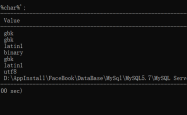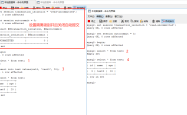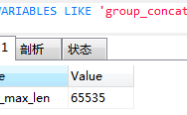mysql常用sql与命令之从入门到删库跑路
启动与停止
启动mysql服务
sudo /usr/local/mysql/support-files/mysql.server start
停止mysql服务
sudo /usr/local/mysql/support-files/mysql.server stop
重启mysql服务
sudo /usr/local/mysql/support-files/mysql.server restart
进入mysql目录文件
cd /usr/local/mysql/support-files
进入mysql命令行
/usr/local/mysql/bin/mysql -uroot -p12345678
退出数据库
exit;
数据库相关操作
查询所有数据库
show databases;
选择(使用)数据库
use mybatis;
查询当前正在使用的数据库名称
select database();
创建数据库
create database 数据库名称;
创建数据库,判断不存在,再创建: create database if not exists 数据库名;
删除数据库
drop database 数据库名称;
判断数据库存在,存在再删除:drop database if exists 数据库名称;
数据库表相关操作
创建数据库表
?| 1 2 3 4 5 6 | create table 表名( 列名1 数据类型1, 列名2 数据类型2, .... 列名n 数据类型n ); |
复制表
create table 表名 like 被复制的表名;
查看某个数据库中的所有的数据表
show tables;
查看数据表的结构
desc pet;或describe pet;
修改表名
alter table 表名 rename to 新的表名;
修改表的字符集
alter table 表名 character set 字符集名称;
添加一列
alter table 表名 add 列名 数据类型;
删除列
alter table 表名 drop 列名;
删除表
drop table 表名;或drop table if exists 表名 ;
添加数据
insert into 表名(列名1,列名2,...列名n) values(值1,值2,...值n);
其中列名和值要一一对应。如果表名后,不定义列名,则默认给所有列添加值,如:insert into 表名 values(值1,值2,...值n);除了数字类型,其他类型需要使用引号(单双都可以)引起来.
删除数据
delete from 表名 where 条件
其中:如果不加条件,则删除表中所有记录。如果要删除所有记录, 使用delete from 表名;一般不推荐使用。这种操作有多少条记录就会执行多少次删除操作.
truncate table 表名;推荐使用,效率更高 先删除表,然后再创建一张一样的表.
修改数据
?update 表名 set 列名1 = 值1, 列名2 = 值2,... where 条件;如果不加任何条件,则会将表中所有记录全部修改.
| 1 2 3 | insert into user2 values (1, '李四' , '123' ); // 增 delete from pet where ower = 'disn' ; //删 update pet set name = '后裔' where ower = 'dfn' ; //改 |
查询数据
?| 1 2 3 4 5 6 7 8 9 10 11 12 13 14 15 16 17 18 19 20 21 22 23 24 25 26 27 | ①> 、< 、<= 、>= 、= 、<> ② between ... and ③ in ( 集合) ④ like 模糊查询 ⑤_单个任意字符 ⑥%多个任意字符 ⑦ is null ⑧ and 或 && ⑨ or 或 || ⑩ not 或 ! 查询条件应用举例: select * from user where age >= 18; select * from user where age >= 18 and age <=36; select * from user where age between 40 and 70; select * from user where age in (6,18,37); // 关于 null select * from user where height = null ; 错误,因为 null 值不能使用=或(!=) 判断 select * from user where height is null ;(正确) select * from user where height is not null ;(正确) // 查询姓陈的有哪些?< like > select * from user where name like '陈%' ; // 查询姓名第二个字是新的人 select * from user where name like "_新%" ; // 查询姓名是三个字的人 select * from user where name like '___' ; // 查询姓名中包含狗的人 select * from user where name like '%狗%' ; |
约束相关
主键约束 (primary key)
能够唯一确定一张表中的的一条记录,我们通过给某个字段添加约束, 可以使得这个字段不重复且不为空.
?| 1 2 3 4 5 6 7 8 9 10 11 | create table user ( id int primary key auto_increment, // 在创建表时,添加主键约束,并且完成主键自增 name varchar (20) ); -- 联合主键: 由多个字段联合组成的主键, 只要联合的主键加起来不重复就可以.联合主键中的任何一个字段都不能为空. create table user2 ( id int , name varchar (20), password varchar (20), primary key (id, name ) ); |
表创建完成后:
添加主键.如:
①alter table user add primary key(id);
②alter table user modify id int primary key;
删除主键:alter table user drop primary key;
唯一约束:unique 约束修饰的字段的值不可以重复.
?| 1 2 3 4 5 6 7 8 9 10 | create table user1 ( id int primary key auto_increment, phone_num varchar (20) unique ); create table user2 ( id int primary key auto_increment, name varchar (20), unique (id, name ) // 表示两个字段在一起不重复就可以 ); |
也可以在表创建完成后, 通过alter table user3 add unique(phone_num);或alter table user3 modify phone_num varchar(20) unique;来添加unique约束.
删除unique约束:alter table user3 drop index phone_num;
非空约束:not null 修饰的字段不能为空null
?| 1 2 3 4 | create table user3 ( id int primary key auto_increment, name varchar (20) not null ); |
删除非空约束:alter table user3 modify name varchar(20);
默认约束
当我们插入字段值时候,如果对应的字段没有插入值,则会使用默认值.如果传入了值,则不会使用默认值.
?| 1 2 3 4 5 | create table user4( id int primary key auto_increment, age int default 18, name varchar (20) not null ); |
外键约束:foreign key
?| 1 2 3 4 5 6 7 8 9 10 11 12 13 14 15 16 17 18 | create table 表名( .... 外键列 constraint 外键名称 foreign key (外键列名称) references 主表名称(主表列名称) ); // 班级 create table classes( id int primary key , name varchar (20) ); // 学生表 create table student ( id int primary key , name varchar (20), class_id int , foreign key (class_id) references classes(id) ); |
数据库查询进阶
?
| 1 2 3 4 5 6 7 8 9 10 11 12 13 14 15 16 17 18 19 20 21 22 23 24 25 26 27 28 29 30 31 32 33 34 35 36 37 38 39 40 41 42 43 44 45 46 47 48 49 50 51 52 53 54 55 56 57 58 59 60 61 62 63 64 65 66 67 68 69 70 71 72 73 74 75 76 77 78 79 | 查询所有记录 例如:查询student表中的所有记录. select * from student; 查询指定字段 例如:查询student中的sname,ssex,class. select sname,ssex,class from student; 查询教师表中所有的单位即不重复的depart列. <排除重复 distinct > select distinct depart from teacher; 查询score表中成绩在60到80之间的所有记录 <查询区间 between … and …> select * from score where degree between 60 and 80; select * from score where degree > 60 and degree < 80; 查询score表中成绩为85,86或88的记录 select * from score where degree in (85, 86, 88); 查询student表中 '95031' 班或性别为 '女' 的同学记录. < or 表示或者> select * from student where class = '95031' or sex = '女' ; 以class降序查询student表的所有记录 <降序: desc , 升序 asc ,默认升序(省略)>. select * from student order by class desc ; 以cno升序,degree降序查询score表的所有记录 select * from score order by cno asc ,degree desc ; 查询 "95031'班的学生人数 <统计 count> select count(*) from student where class = '95031'; 查询score表中最高分的学生学号和课程号(子查询) select sno, cno from score where degree = (select max(degree) from score );其中:select max(degree) from score 先查出最高分. select sno,cno degree from score order by degree desc limit 0,1;其中:limit第一个数字表示从多少开始,第二个表示多少条.当有多个相同最高分时,容易出bug,不推荐使用这种方式查询. 查询每门课的平均成绩 select cno, avg(degree) from score group by cno; 查询score表中至少有2名学生选修的并以3开头的课程的平均分数. select cno, avg(degree) from score group by cno having count(cno) >= 2 and cno like '3%'; 查询分数大于70, 小于90的sno列. select sno, degree from score where degree between 70 and 90; 查询所有学生的sname, cno和degree列. select sname, cno, degree from student, score where student.sno = score.sno; 查询所有学生的sno,cname和degree列 select sno,cname,degree from course ,score where course.cno = score.cno; 查询" 95031 "班学生每门课的平均分. select cno, avg(degree) from score where sno in (select sno from student where class = '95031') group by cno; 查询选修" 3-105 "课程的成绩高于" 109 "号同学" 3-105 "成绩的所有同学的记录. select * from score where cno = '3-105' and degree > (select degree from score where sno = '109' and cno = '3-105'); 查询成绩高于学号为" 109 ", 课程号为" 3-105 "的成绩的所有记录 select * from score where degree > (select degree from score where sno = '109' and cno = '3-105'); 查询和学号为108,101的同学同年出生的所有的sno, sname, sbirthday select *from student where year(sbirthday) in (select year(sbirthday) from student where sno in(108, 101)); 查询" 张旭 "教师任课的学生成绩 select * from score where cno = ( select cno from course where tno = (select tno from teacher where tname = " 张旭 ")); 查询选修某课程的同学人数多于5人的教师姓名. select tname from teacher where tno = (select tno from course where cno = (select cno from score group by cno having count(*) > 5)); 查询存在有85分以上的成绩的课程的cno select cno, degree from score where degree > 85; 查询出" 计算机系 "教师所教课程的成绩表 select * from score where cno in (select cno from course where tno in (select tno from teacher where depart = " 计算机系 ")); 查询选修编号为" 3-105 "课程且成绩至少高于选休息编号为" 3-245"的同学的cno,sno和degree,并按degree从高到低次序排序. any 至少一个. |
| 1 | select * from score where cno = '3-105' and degree > any ( select degree from score where cno = '3-245' ) order by degree desc ; |
查询选修编号为"3-105"课程且成绩高于选休息编号为"3-245"的同学的cno,sno和degree,并按degree从高到低次序排序.
all 表示所有
| 1 | select * from score where cno = '3-105' and degree > all ( select degree from score where cno = '3-245' ) order by degree desc ; |
查询所有教师和同学的name, sex和birthday
select tname as name, tsex as sex, tbirthday as birthday from teacher union select sname, ssex, sbirthday from student;
查询所有"女"教师和"女"同学的name,sex和birthday
select tname as name, tsex as sex, tbirthday as birthday from teacher where tsex = '女' union select sname, ssex, sbirthday from student where ssex = '女';
查询成绩比该课程成绩低的同学的成绩表
思路: 从a表查出对应的分数跟b表筛选出来的平均分作比较.
| 1 2 3 4 5 6 7 8 9 10 11 12 13 14 15 16 17 18 19 20 21 22 23 24 25 26 27 28 29 30 31 32 33 34 35 36 37 | select * from score a where degree < ( select avg (degree) from score b where a.cno = b.cno); 表a + -----+-------+--------+ | sno | cno | degree | + -----+-------+--------+ | 101 | 3-105 | 91 | | 102 | 3-105 | 92 | | 103 | 3-105 | 92 | | 103 | 3-245 | 86 | | 103 | 6-166 | 85 | | 104 | 3-105 | 81 | | 105 | 3-105 | 88 | | 105 | 3-245 | 75 | | 105 | 6-166 | 79 | | 109 | 3-105 | 76 | | 109 | 3-245 | 68 | | 109 | 6-166 | 81 | + -----+-------+--------+ 12 rows in set (0.00 sec) 表b | sno | cno | degree | + -----+-------+--------+ | 101 | 3-105 | 91 | | 102 | 3-105 | 92 | | 103 | 3-105 | 92 | | 103 | 3-245 | 86 | | 103 | 6-166 | 85 | | 104 | 3-105 | 81 | | 105 | 3-105 | 88 | | 105 | 3-245 | 75 | | 105 | 6-166 | 79 | | 109 | 3-105 | 76 | | 109 | 3-245 | 68 | | 109 | 6-166 | 81 | + -----+-------+--------+ 12 rows in set (0.00 sec) |
查询所有任课教师的tname和depart
select tname, depart from teacher where tno in (select tno from course);
查询至少有两名男生的班号
select class from student where ssex= '男' group by class having count(*) > 1
查询student表中不姓"王"的同学记录
select * from student where sname not like '王%';
查询student表中每个学生的姓名和年龄
select sname, year(now()) - year(sbirthday) as '年龄' from student;
查询student表中最大和最小的sbirthday日期值
select max(sbirthday) as '最大', min(sbirthday) as '最小' from student;
以班号和年龄从大到小的顺序查询student表中的全部记录
select * from student order by class desc, sbirthday;
查询"男"教师及其所上的课程
select * from course where tno in (select tno from teacher where tsex = '男');
查询最高分同学的sno, cno和degree列
select * from score where degree = (select max(degree) from score);
查询和李军同性别的所有同学的sname
select sname from student where ssex = (select ssex from student where sname = '李军');
查询和李军同性别并同班 同学sname
select sname from student where ssex = (select ssex from student where sname = "李军") and class = (select class from student where sname = '李军');
查询所有选修"计算机导论"课程的"男"的成绩表
select * from score where cno = (select cno from course where cname = '计算机导论') and sno in(select sno from student where ssex = '男');
sql的四种连接查询
?
| 1 2 3 4 5 6 7 8 9 10 11 12 13 14 15 16 17 18 19 20 21 | 分析用例的数据准备: mysql> select * from person; + ----+--------+--------+ | id | name | cardid | + ----+--------+--------+ | 1 | 张三 | 1 | | 2 | 李四 | 3 | | 3 | 王五 | 6 | + ----+--------+--------+ 3 rows in set (0.00 sec) mysql> select * from card; + ------+-----------+ | id | name | + ------+-----------+ | 1 | 饭卡 | | 2 | 建行卡 | | 3 | 农行卡 | | 4 | 工商卡 | | 5 | 邮政卡 | + ------+-----------+ 5 rows in set (0.00 sec) |
内连接
inner join 或者 join, 后面通常跟对一个on表示条件
---- 内联查询: 就是两张表中的数据, 通过某个字段相等,查询出相关记录数据.
<当前表中的cardid与id相同.>
| 1 2 3 4 5 6 7 8 | select * from person inner join card on person.cardid = card.id; + ----+--------+--------+------+-----------+ | id | name | cardid | id | name | + ----+--------+--------+------+-----------+ | 1 | 张三 | 1 | 1 | 饭卡 | | 2 | 李四 | 3 | 3 | 农行卡 | + ----+--------+--------+------+-----------+ 2 rows in set (0.00 sec) |
外连接
左外连接:左连接 left join 或者 left outer join
---- 左外连接, 会把左边表里面的所有数据取出来, 而右边表中的数据,如果有相等的,就显示出来, 如果没有, 则会补null.
| 1 2 3 4 5 6 7 8 9 10 | select * from person left join card on person.cardid = card.id; + ----+--------+--------+------+-----------+ | id | name | cardid | id | name | + ----+--------+--------+------+-----------+ | 1 | 张三 | 1 | 1 | 饭卡 | | 2 | 李四 | 3 | 3 | 农行卡 | | 3 | 王五 | 6 | null | null | + ----+--------+--------+------+-----------+ 3 rows in set (0.00 sec) |
右外连接:右连接 right join 或者right outer join
----右外连接, 会把右边表里面的所有数据取出来, 而左边表中的数据,如果有相等的,就显示出来, 如果没有, 则会补null.
?| 1 2 3 4 5 6 7 8 9 10 11 12 | select * from person right join card on person.cardid = card.id; + ------+--------+--------+------+-----------+ | id | name | cardid | id | name | + ------+--------+--------+------+-----------+ | 1 | 张三 | 1 | 1 | 饭卡 | | 2 | 李四 | 3 | 3 | 农行卡 | | null | null | null | 2 | 建行卡 | | null | null | null | 4 | 工商卡 | | null | null | null | 5 | 邮政卡 | + ------+--------+--------+------+-----------+ 5 rows in set (0.01 sec) |
全外连接:完全外连接 full join 或者full outer join<mysql不支持full join>
| 1 2 3 4 5 6 7 8 9 10 11 12 13 14 15 16 17 18 19 | mysql> select * from person full join card on person.cardid= card.id; error 1054 (42s22): unknown column 'person.cardid' in 'on clause' **** 解决mysql不支持 full join 的方法**** <左连接 + 右链接> , 即通过 union 来连接左右连接. <左连接 union 右链接>. eg: select * from person left join card on person.cardid = card.id union select * from person right join card on person.cardid = card.id; + ------+--------+--------+------+-----------+ | id | name | cardid | id | name | + ------+--------+--------+------+-----------+ | 1 | 张三 | 1 | 1 | 饭卡 | | 2 | 李四 | 3 | 3 | 农行卡 | | 3 | 王五 | 6 | null | null | | null | null | null | 2 | 建行卡 | | null | null | null | 4 | 工商卡 | | null | null | null | 5 | 邮政卡 | + ------+--------+--------+------+-----------+ 6 rows in set (0.01 sec) |
要点梳理
where 和 having 的区别?
?(1) having通常用在聚合函数前面,对聚合函数进行过滤,(max、min、count、sum).having通常和group by 一起连用,因为where不能加在group by的后面.
(2) where 在分组之前进行限定,如果不满足条件,则不参与分组。having在分组之后进行限定,如果不满足结果,则不会被查询出来. where 后不可以跟聚合函数,having可以进行聚合函数的判断。
| 1 2 3 4 5 6 7 | mysql执行语句顺序,严格遵循次顺序,不能改变 select from where group by having order by |
mysql的事务
关于事务
mysql中, 事务其实是一个最小的不可分割的工作单元. 事务能够保证一个业务的完整性.
分析:
?| 1 2 3 4 5 6 7 8 9 | 例如: a --> -100 update user set money = money - 100 where name = 'a' ; b --> +100 update user set money = money + 100 where name = 'b' ; -- 实际程序中, 如果只有一条sql语句执行成功了,而另外一条没有执行成功?则会出现前后数据不一致的情况. update user set money = money - 100 where name = 'a' ; update user set money = money + 100 where name = 'b' ; 在多条sql语句,可能会有同时成功的要求,要么就同时失败. |
事务控制
(1)事务主要包含自动提交@@autocommit=1;,手动提交commit;和事务回滚rollback;.
(2) mysql默认是开启事务的(自动提交).
----当我们去执行一个sql语句的时候,效果会立即提现出来,且不能回滚.
set autocommit = 0;设置mysql是否自动提交,<0为否, 1为是.>
select @@autocommit;查看mysql的自动提交方式.
commit; 手动提交.
具体事务控制相关参照下面代码分析:
| 1 2 3 4 5 6 7 8 9 10 11 12 13 14 15 16 17 18 19 20 21 22 23 24 25 26 27 28 29 30 31 32 33 34 35 36 37 38 39 40 41 42 43 44 45 46 47 48 49 50 51 52 53 54 55 56 57 58 59 60 61 62 63 | mysql> select @@autocommit; + --------------+ | @@autocommit | + --------------+ | 1 | + --------------+ 1 row in set (0.00 sec) // 建表 create database bank; create table user ( id int primary key , name varchar (20), money int ); // 首先在表中插入一条用户数据a. insert into user values (1, 'a' ,1000); query ok, 1 row affected (0.00 sec) // 进行回滚操作. mysql> rollback ; query ok, 0 rows affected (0.00 sec) // 执行回滚后,查看数据表信息,发现即使调用了 rollback ,但插入的数据依然存在.说明当前不能回滚. mysql> select * from user ; + ----+------+-------+ | id | name | money | + ----+------+-------+ | 1 | a | 1000 | + ----+------+-------+ 1 row in set (0.00 sec) // 可以通过设置msql的回滚自动提交为 false . set autocommit = 0; query ok, 0 rows affected (0.00 sec) mysql> select @@autocommit; + --------------+ | @@autocommit | + --------------+ | 0 | + --------------+ 1 row in set (0.00 sec) // 也就说, 通过上面的 set autocommit = 0;操作关闭了mysql的自动提交( commit ). *******再次插入数据:******* insert into user values (2, 'b' ,1000); query ok, 1 row affected (0.00 sec) // 插入数据后查看表,用户2数据添加成功. mysql> select * from user ; + ----+------+-------+ | id | name | money | + ----+------+-------+ | 1 | a | 1000 | | 2 | b | 1000 | + ----+------+-------+ 2 rows in set (0.00 sec) // 执行回滚操作. mysql> rollback ; query ok, 0 rows affected (0.00 sec) // 回滚后再次查看表,发现刚才插入的数据已经被干掉了. mysql> select * from user ; + ----+------+-------+ | id | name | money | + ----+------+-------+ | 1 | a | 1000 | + ----+------+-------+ 1 row in set (0.01 sec) **** 对于这种场景,如果想让用户b数据成功提交, 可以通过 commit ;命令执行手动提交操作.手动提交后,如果想再次通过 rollback 来撤销,则是不可以的.也就是说,事务一旦提交,执行的sql语句就不可以再撤销,也就是说事务一旦提交数据就会持久的产生效果. |
(3)手动开启事务
begin和start transaction都可以手动开启一个事务. 也就是说,当我们当前的mysql如果默认的是自动提交模式,则执行rollback进行事务回滚则是无效的. 但是可以通过begin和start transaction手动开启事务.
| 1 2 3 4 5 6 7 8 | 即: 当前默认为自动提交模式,此时执行 rollback 无效.执行下面sql语句: start transaction ;(或者 begin ;) update user set money = money - 100 where name = 'a' ; update user set money = money + 100 where name = 'b' ; 执行完插入a,b用户数据后,再执行 rollback ,发现可以成功回滚事务.可以成功切换成手动开启事务的模式.若想使得插入的数据生效,也需要手动执行 commit 进行提交操作. 事务开启之后,一旦 commit 提交,就不可以回滚,也就说,当前的这个事务在提交的时候就已经结束了. |
事务的四大特征
a 原子性: 事务是最小的单元, 不可以在分割.
c 一致性: 事务要求, 同一事务中的sql语句必须保证同时成功,同时失败.
i 隔离性: 事务1 和事务2之间shi具有隔离性的.
d 持久性: 事务一旦结束(commit,rollback),就不可以返回.
事务的隔离性
多个事务之间隔离的,相互独立的。但是如果多个事务操作同一批数据,则会引发一些问题,设置不同的隔离级别就可以解决这些问题.
存在问题:
(1) 脏读:一个事务,读取到另一个事务中没有提交的数据.
(2)不可重复读(虚读):在同一个事务中,两次读取到的数据不一样.
(3)幻读:一个事务操作(dml)数据表中所有记录,另一个事务添加了一条数据,则第一个事务查询不到自己的修改.
read uncommitted; 读未提交的–>产生的问题:脏读、不可重复读、幻读.
read committed; 读已经提交的–>产生的问题:不可重复读、幻读repeatable read; 可以重复读–>产生的问题:幻读
serializable; 串行化<性能特差>
通常是隔离级别越高,性能越差.
(1)查看数据库的隔离级别
mysql默认的隔离级别: repeatable-read
mysql8.0:
系统级别的:select @@global.transaction_isolation;
会话级别的:select @@transaction_isolation;
mysql5.x:
系统级别的:select @@global.tx_isolation;
会话级别的:select @@tx_isolation;
| 1 2 3 4 5 6 7 | mysql> select @@ global .transaction_isolation; + --------------------------------+ | @@ global .transaction_isolation | + --------------------------------+ | repeatable - read | + --------------------------------+ 1 row in set (0.00 sec) |
(2)修改隔离级别
set global tansaction isolation level read uncomitted;
数据库的三大范式
第一范式
数据表中的所有字段都是不可分割的原子项.初步可以理解为:字段值还可以继续拆分的,就不满足第一范式.
比如某表中有一个address的字段,插入值为"中国陕西省西安市碑林区柏树林11号".该字段值是可以继续拆分的,原则上就不满足第一范式.可以依次拆分为:国家/省/市/区/街道等等.
当然,范式设计的越详细,对某些实际操作可能会更好.但不一定都是好处.<比如对address字段来说,可能拆分开来永远都用不到这么详细的信息,可能就没有拆分的必要.>
第二范式
必须是满足第一范式的前提下,第二范式要求,除主键外的每一列都必须完全依赖主键.如果要出现不完全依赖,只可能发生在联合主键的情况下.
?| 1 2 3 4 5 6 7 8 9 10 11 12 13 14 15 16 17 18 19 20 21 22 23 | 例如: create table myorder( product_id int , customer_id int , product_name varchar (20), customer_name varchar (20), primary key (product_id, customer_id ); 当前表中, 除主键以外的其他列, 只依赖于主键的部分字段.则不满足第二范式,通常需要拆表. create table myorder( order_id int primary key , product_id int , customer_id int ); create table product ( id int primary key , name varchar (20) ); create table customer( id int primary key , name varchar (20) ); 拆分成三个表后,满足第二范式. |
第三范式
必须先满足第二范式.除开主键列的其他列之间不能有传递依赖关系.
附件
查询语句所涉及的sql语句
?| 1 2 3 4 5 6 7 8 9 10 11 12 13 14 15 16 17 18 19 20 21 22 23 24 25 26 27 28 29 30 31 32 33 34 35 36 37 38 39 40 41 42 43 44 45 46 47 48 49 50 51 52 53 54 55 56 57 58 59 60 61 62 63 64 65 66 67 68 69 70 71 72 73 74 75 76 77 78 79 80 81 82 83 84 85 86 87 88 89 90 91 | create table student( sno varchar (20) primary key , sname varchar (20) not null , ssex varchar (20) not null , sbrithday datetime, class varchar (20) ); create table student( sno varchar (20) primary key , sname varchar (20) not null , ssex varchar (10) not null , sbirthday datetime, class varchar (20) ) create table teacher( tno varchar (20) primary key , tname varchar (20) not null , tsex varchar (20) not null , tbirthday datetime, prof varchar (20) not null , depart varchar (20) not null ); create table course( cno varchar (20) primary key , cname varchar (20) not null , tno varchar (20) not null , foreign key (tno) references teacher(tno) ); create table score( sno varchar (20) not null , degree decimal , primary key (sno, cno), foreign key (sno) references student(sno), foreign key (cno) references course(cno) ); insert into student values ( '101' , '曾华' , '男' , '1977-09-01' , '95033' ); insert into student values ( '102' , '匡明' , '男' , '1975-10-02' , '95031' ); insert into student values ( '103' , '王丽' , '女' , '1976-01-23' , '95033' ); insert into student values ( '104' , '李军' , '男' , '1976-02-20' , '95033' ); insert into student values ( '105' , '王芳' , '女' , '1975-02-10' , '95031' ); insert into student values ( '106' , '陆君' , '男' , '1974-06-03' , '95031' ); insert into student values ( '107' , '王尼玛' , '男' , '1976-02-20' , '95033' ); insert into student values ( '108' , '张全蛋' , '男' , '1975-02-10' , '95031' ); insert into student values ( '109' , '赵铁柱' , '男' , '1974-06-03' , '95031' ); insert into teacher values ( '804' , '李成' , '男' , '1958-12-02' , '副教授' , '计算机系' ); insert into teacher values ( '856' , '张旭' , '男' , '1969-03-12' , '讲师' , '电子工程系' ); insert into teacher values ( '825' , '王萍' , '女' , '1972-05-05' , '助教' , '计算机系' ); insert into teacher values ( '831' , '刘冰' , '女' , '1977-08-14' , '助教' , '电子工程系' ); insert into course values ( '3-105' , '计算机导论' , '825' ); insert into course values ( '3-245' , '操作系统' , '804' ); insert into course values ( '6-166' , '数字电路' , '856' ); insert into course values ( '9-888' , '高等数学' , '831' ); insert into score values ( '103' , '3-245' , '86' ); insert into score values ( '105' , '3-245' , '75' ); insert into score values ( '109' , '3-245' , '68' ); insert into score values ( '103' , '3-105' , '92' ); insert into score values ( '105' , '3-105' , '88' ); insert into score values ( '109' , '3-105' , '76' ); insert into score values ( '103' , '3-105' , '64' ); insert into score values ( '105' , '6-166' , '79' ); insert into score values ( '109' , '6-166' , '81' ); create table person( id int primary key auto_increment, name varchar (20), cardid int ); create table card ( id int , name varchar (20) ); insert into card values (1, '饭卡' ); insert into card values (2, '建行卡' ); insert into card values (3, '农行卡' ); insert into card values (4, '工商卡' ); insert into card values (5, '邮政卡' ); insert into person values (1, '张三' ,1); insert into person values (2, '李四' ,3); insert into person values (3, '王五' ,6); |
到此这篇关于mysql常用sql与命令之从入门到删库跑路的文章就介绍到这了,更多相关mysql 入门内容请搜索服务器之家以前的文章或继续浏览下面的相关文章希望大家以后多多支持服务器之家!
原文链接:https://blog.csdn.net/weixin_45108087/article/details/102766281
1.本站遵循行业规范,任何转载的稿件都会明确标注作者和来源;2.本站的原创文章,请转载时务必注明文章作者和来源,不尊重原创的行为我们将追究责任;3.作者投稿可能会经我们编辑修改或补充。











